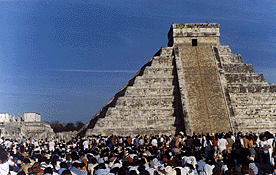|
Accommodation: family, residence at school or shared apartment.
- Arrival on Sunday.
- Departure on Saturday.
-
Host family accommodation is available in Playa del Carmen throughout the year. Most families live within a 20 minute walk from the school. Very occasionally a family may be up to 15-20 minutes from the school by public transport. The majority of our Mexican host families live in relatively new, one or two-storey houses, although some live in apartments. A typical house will have a living room/dining room, a kitchen and bathroom and 3 or 4 bedrooms. There is often a yard outside which people use as an extension of the house. Note that very few families have air-conditioning, although most families will be able to provide their guest students with a fan. The families will often have children or grandparents living with them so there is normally plenty of opportunity for conversation practice!
Be prepared for the fact that few families will speak another language, although those that work in tourism may have an elementary level of English, French or German. All host families are carefully selected by our Accommodation Department and all agree to fulfil the following conditions:
- To provide students with single rooms (unless a couple both attending courses or individuals request to share), which are comfortably furnished, have adequate lighting and a desk or table where students can work.
- To change bed linen and towels weekly.
- To make a daily bath or shower available.
- To provide an adequate continental breakfast and -- for those students who are being accommodated on a half-board basis -- a substantial dinner at night.
- To provide students with a door key so that they can let themselves in and out.
- To treat students as family guests and generally behave in a friendly and hospitable manner.
-
Our purpose-built student residence opened in June 2005 and quickly became our students' most popular accommodation option. The residence is located in the centre of Playa del Carmen, in a very quiet street, beside the town's main church and just two blocks (or a 5-minute walk) from the school. The residence has three floors and a basement. The ground floor consists of the reception, an office, the kitchen and 6 bedrooms; there are a further 10 bedrooms on the first floor and the second floor has 6 bedrooms and four terraces. All 22 bedrooms have twin beds and each bedroom has its own private bathroom. Bedrooms also have a desk, a TV, ceiling fans and air-conditioning, as well as a small fridge. You can choose between bed and breakfast and half board (evening meal). Note that meals are served in the residence itself. If you prefer, you can have the "no meals" option, in which case you can use the fully-equipped kitchen in the residence.
-
The school has a number of furnished apartments available for rent, which you can share with other students, or rent for your own, exclusive use. The normal minimum period for renting an apartment is 2 weeks, although shorter rentals can sometimes be arranged on request.
These apartments are entirely self-catering, which means that no meals are provided.
The school has a number of apartments on-site (see below for details). All other apartments are
centrally located and are therefore between 5-20 minutes from the school on foot or by public
transport.
Your apartment includes:
- your own individual bedroom
- sheets and towels (but you should bring your own beach towels)
- use of the kitchen, bathroom and living room and/or terrace
- cleaning and change of bed linen once a week
- keys, so that you can can and go as you please
When bookings are confirmed we will send you the address of the apartment.
On-site apartments
The school has a number of apartments available on the school premises. On-site apartments are cleaned every day except Sundays. We wash and replace sheets and towels once a week but there is no on-site laundry service. Instead, you have a local laundrette one block away, which charges approximately 2 US$ per kilo to wash, dry and fold clothes. If you are staying in our on-site apartments have full access to the garden as well as keys to the front door of the school building so that you can come and go as you please. We rely on you to keep the front door locked when the school is closed.
Booking fee (once): 50$US
Price per night, per person:
FAMILY:
30$US (B&B)
35$US (2 meals per day)
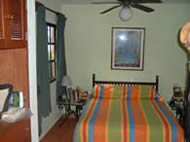
RESIDENCE: *
33$US single, no meal
38$US single, breakfast
48$US single, 2 meals per day
23$US double no meal
28$US double, breakfast
38$US double 2 meals per day
* If 27 nights or more, 3$US discount per night, per person
RESIDENCE VIDEO
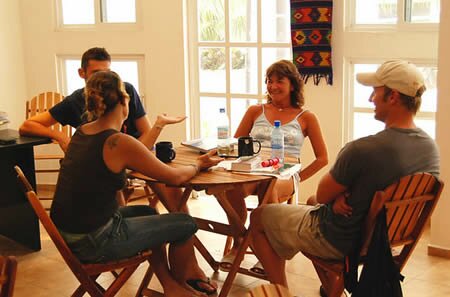
APARTMENT:
SHARED ...... 40$US single
SHARED ...... 28$US double
PRIVATE (1 bedroom) 70$US (price per apartment per night)
PRIVATE (2/3 bedrooms) 85$US (price per apartment per night)
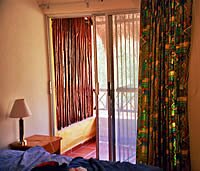 
|
|
City information
Click on Pictures to see in large size
5 days weather forecast
Originally named Xaman-Ha (waters of the north) Playa del Carmen is a living vibrant part of the Maya World (Mundo Maya). Located on the beautiful Mexicana Caribbean coast some 40 miles (60 km.) south of Cancun, Playa , as it is now affectionately known, is the perfect base from which to explore the fascinating sites along the Cancun -Tulum Corridor of Quintana Roo ( now called Mayan Riviera ). Playa del Carmen is blessed with miles of unspoiled white sandy beaches and crystal-clear Caribbean waters that's proving harder and harder to find. It's a place for those in search of the real Caribbean. Experience Playa del Carmen and the endless adventures Mundo Maya has to offer.
This archaeological city of the state of Yucatan was founded by the Maya-Itzas who came led by Itzamna after separating from Acalon. They arrived in the Peninsula around the year 435-455 A.D.. Chichen was occupied twice. The first occupation was from 495 to 692, and the second from 948 to 1204. The architecture of the first period is considered to be authentically Maya, and the second is considered to have Toltec influence, since it has certain elements in common with those found in Tula, the ancient capital of the Toltec-Hueytlapalanecas.
The zone measures 3 km from North to South and 2 km from West to East. This zone contains so many constructions that it gives us an idea of how important this city was to the Maya. In general these buildings can be divided into two groups, according to the era in which they were built:
Those of the Classic Maya period, which covers the Seventh to Tenth centuries. In this group these buildings are found: The Nunnery and its annexes, the Akab Dzib, the Temple of the three lintels, the Red House , that of the Phallus and that of the Deer. In the Maya Toltec group constructed between the Tenth century and the Thirteenth century, we have the Castle, The Temple of the Warriors , the Ball Court, the Thousand Columns group, the Tzopantli, the Osary , the platforms of Venus and of the Tigers and of the Eagles. The Astronomical Observatory (Caracol) belongs to a transition phase. The city has as its main axis two cenotes , Xtoloc, which provided the city with water, and the Sacred Cenote, where offerings of maidens and children were made to the gods. It has a diameter of 60 meters with a depth of to the water of 12 meters. In 1900, the North American, Edward Thompson, who lived in the Hacienda Chichen extracted a multitude of objects from this cenote. Other explorers who studied Chichen were: Francisco Montejo, "The Advanced", the conqueror of Yucatan in 1527; Stephens and Caterwood, in 1841-42; Le Plongeon in 1875; Maudslay, Maler and others took care of divulging this Maya city to the world.
Among the buildings of outstanding beauty and worthy of being seen are: The Castle, a pyramid 60 meters on each side and 24 meters in height and ending in an flattened summit. On top of it there is a temple. The pyramid has nine terraces and four stairways- one toward each cardinal point.- leading to the temple consisting of a portical , a perimeter gallery and a sanctuary at the top.
This pyramid is believed to be superimposed over one made at a prior time It has a passageway on one side of the North stairway. You can climb some steps to a place where there are the sculptures of a Chac-mool and a jaguar painted red and encrusted with jade and turquoise . The High Priest is believed to have sat on its back while passing down judgment, during the era when the priests occupied the office of civil and religious authority. (Classic Period)
The Ball Court is an enormous construction 168 meters long and 70 wide. It is made up of two vertical walls, one facing the other with a distance of 36 meters between them. In the center part there is a circular ring decorated with intertwined snakes and cosmic glyphs. At the extremes of the patio are two tribunals which were supposedly for the principal lords. This construction has an echo effect and impressive acoustics . If a person stands under one of the rings and claps his hands or shouts , the sound is repeated seven times. The people in the tribunals can have a conversation in a whisper with a person at the opposite end of the patio. This is an experience not to be missed.
In recent times, this enclosure has been used for concerts, symphonies and choral groups from different countries. At this time the magno-concert of Italian opera singer, Luciano Pavaroti, is being prepared. The walls rest on platforms in talud where there are mosaics and glyphs in bas-relief representing warriors and principal lords in different poses and scenes. On top of the eastern wall there is a temple with some serpentine columns holding the jamb. It is supposed that the Main Chief watched the ball game, a ritual for the Maya, from the interior of this structure. This temple can be reached by an exterior stairway on the South side.
The Temple of the Warriors is a pyramid, also ending in a flattened summit, with a square base 40 meters on each side . It is lower than the Castle because it only has four superimposed terraces which have scenes decorated with personages, eagles and tigers. The upper part has walls of what was a a ritual building , rectangular in shape 21 meters on each side The roof is sustained by a series of pillars decorated with figures representing the monster of the Earth , a priest , and the Bacab who to the Mayas was the one who held up the world. The pillars are located in each of the cardinal directions, each with its own colour. On the facade of this building there are two serpentine columns forming the entrance. These are very similar to those in the main building of the Ball Court . Both support a wood lintel with decorations and glyphs. This building is reached by climbing a stairway on the west side of the entire structure. But before getting to it , one passes in front of a low platform where there are a multitude of pillars forming part of the group called The Thousand Columns .
This structure is very similar to one found in Tula, the ancient capital of the Toltec Hueytlapallanecas , called the Temple of Tlahuizcalpantecutli "the Lord of the Dawn ". This , together with other temples with Toltec elements, is the reason that Chichen is considered as the city of Yucatan with the most influence of the Toltec culture. The group of the thousand columns is made up of a series of columns whose position is in the form of an irregular square. On the south side it is completed by a building called the market , but it is obvious that it formed a part of the columns according to the Maya idea of architecture. In its conformation, three sections can be distinguished: The northern section, consisting of 156 columns placed four deep with a length of 125 meters by 20; the east section made up of 134 columns, including some that are in a temple on the same side. , and the west, by the ones that form the entrance of the rectangle and are placed in four rows in an extension of 125 by 11 meters . On the south side, which is closed, is the rectangle of a large construction called the Market , which has a small ball court on its east side. Other constructions found around the Castle are: The platform of Venus, a small monument in the northern part of the castle. It has a square base and each of its sides has a stairway with serpentine decorations ending with the sculptured head of the mythical reptile, a presentation of a man-bird -serpent, the symbol of the Quetzalcoatl and of Kukulcan. It also has a chronological sign associated with the planet Venus,from which it gets its name. It has been called "The tumb of Chac-mool" , the sculpture of this personage having been found there.
Between there and "The Ball Court" is The Platform of the Tigers and Eagles and the "Tzompantli. The Ball Court is a construction like that of Venus, except that on its wall jaguars and eagles with human hearts in their claws are carved . Since this is of the toltec period, it probably was used for sacrificing the captives. Very close to the platform , there is a foundation with walls decorated with human skulls called the "Tzompantli." Perhaps the skulls represented the people who had been sacrificed. In this zone, on the north side of the castle, is the Sac-be, or white road, which was a wide foot path leading towards the "Sacred Cenote". This was a natural depression with borders cut vertically with a diameter of 60 meters and a depth to the water of 12 to 15 meters.The southern part has a small altar from which , according to legend , after a religious ceremony , victims who had been chosen to be sacrificed to the gods were thrown.
On the south side of the Castle is a series of buildings which include "The Osary", "The house of the deer", "The red house", "The Caracol", "The Nunnery", "The Church", "The Temple of the Panels " and "The Akab-Dzib". The Osary has its name because there is a row of seven tombs of Maya personages in the interior, with jade and ceramic offerings. This building is a flat topped pyramid, with 4 stairways on each side and a height of 10 meters. At the summit are the ruins of what was probably a temple. This building belongs to the Maya-Toltec style, and has stairways decorated with serpentine.
"The Red House": This building has its name because it has a sash of red colour on its facade. It is considered to be a part of the Maya constructions of the Puuc style, those which do not have a marked toltec influence. It rests on a platform with round corners . It is made up of a portico with hieroglyphic inscriptions, three rooms, that which represents it and sets it apart are some "roof combs" , ornaments that give the building addition height. One of these is of medial mouldings and the other has a mask of the god Chaac. Close by, on the west side, is the "House of the Deer", named for a picture with figures of these animals found inside. It is like the Red House , but simpler in its architectonic elements.
Leaving this part and going south, there are some buildings in the process of restoration. Then finally a wide square is reached. In the east of this, is "The Observatory" or "Caracol", as it is commonly known since it has a winding staircase in its interior. This building is made up of a rectangular platform with a narrow stairway in the western part giving access to the terrace where the observatory rises . It has openings in various cardinals points, which must have served for the observation of the stars, since it has a circular structure similar to contemporary observatories.
Still going south, we find the temple of the Sculpted Panels ; several figures in relieve of warriors, trees and animals are conserved on its walls. And further on is the building of "The Nunnery", a colossal fortification with a foundation of 70 by 35 meters and a height of 18 meters. It has a staircase divided into two bodies, in the northern part it gives access to a structure with a rectangular base made up of two large parallel halls . Its decoration of tapered medial mouldings, is pure Mayan style without toltec influence. On the east side, an annex is found . This construction has two richly ornated facades; The one on the north side has three doors with stone lintels and masks of the god Chaac in its corners; the other facade on the east has extremely complicated ornaments. It has masks and a cornice on which there is a series of noses of the god Chaac.On this is a panel with medial moulding, and in the middle, a richly dressed personage in high relieve in the center of a circle of beams or feathers. The other building which forms part of the "Nunnery" , is the "Church". It is rectangular with a single entrance door found in its western part. The lower part of the front only has worked stones without decoration, but on the level of the doors, is a thick cornice having a series of medial mouldings surrounding the entire building, where there is a panel with masks, on which the four Bacabs in their representations of snail, armadillo, turtle and rabbit appear. There is a moulding over this that enclose a sort of sash between two inclining columns, next there is a border of medial mouldings supporting the roof combs, that have a series of masks, identified with the god Chaac. This building is the most richly carved, considering its size.
Behind this building at about 90 meters, is the "Akab Dzib", so called for the lintels inside that "only the pure" can read . Since the building has thick walls , its interior is dark and it is not easy to read its content. Also the name can be translated as "the writing that is read at night". It is in pure Maya style and is formed by a solid center, a hall to the west and constructions to the north and to the south. In this last one are sculptures of warriors and some inscriptions, as well as some red hands, which are believed to be the hands of Zamna, the major god of the Mayas. Besides these two section, in which we can distinguish or try to distinguish two construction styles: the Maya and the Toltec , Chichen Itza has another series of constructions much farther to the south. These building which are a little difficult to get to, are given the name Old Chichen. Among them we have: The Date Group which are two Atlantides supporting a lintel with some calendar type inscriptions corresponding , according to the GMT correlation , to the year 879 AD The principal group to the south east includes the Castle of Old Chichen and the Temple of the Jaguars . There the Temple of the Sculptured Lintels is found, as well as the cornice of the Birds Group, and that of the three Lintels, and that of the Turtles.
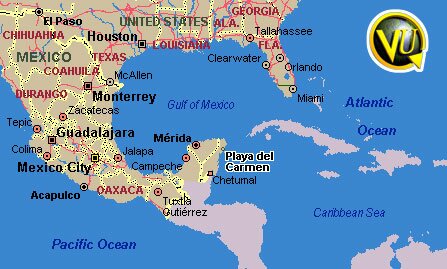
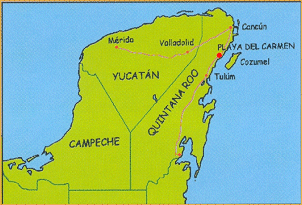
|



